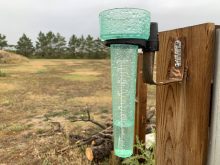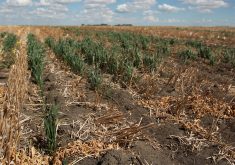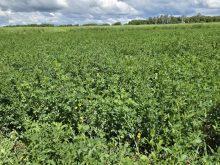MEDICINE HAT — Cattle producers face headwinds in 2024 ranging from higher rates of open cattle to depleted pastures and worries about water shortages and fires.
The situation weighs heavily on Kim Wachtler, who ranches along Alberta’s Cowboy Trail near Claresholm, Alta.
Related stories in this issue:
- Communities feel pinch as river levels plummet
- Sask. watches water levels closely
- Low water levels affect southern Alta. power generation
Read Also

Drones now used to assess wildlife crop damage in Saskatchewan
Wildlife damage in Saskatchewan crops is now assessed by drones and artificial intelligence.
The Burke Creek ranch history dates back to the earliest days of cattle in the province, when it was established in 1890 next to a natural spring.
“We are really blessed that our operation is really well watered by natural springs and creeks and streams,” said Wachtler. “But this last year or two, we’ve had springs — and my dad is in his mid-70s and he’s never seen them not running — and we’ve seen them dry up.”
The springs usually run hard enough to avoid freezing, even on the coldest of days, but that changed during the January cold snap.
“This last go round in that deep freeze, we’ve never had such a problem keeping water going than we did this year because the pressure is so low coming out from the ground.”
Wachtler said a lot of planning is underway for the ranch as it prepares for water shortages, destocking and potential fire.
“A lot of people struggled with what to do last year,” she said, noting her operation ran 30 percent fewer cattle to preserve available forage.
As tough as 2023 was, 2024 is poised to be tougher if conditions don’t change.
Historically, they do change as southern Alberta transitions from dry winter conditions to early spring snowstorms followed by June rains.
Even so, the anxiety level is rising in the absence of needed precipitation.
The nearby forestry grazing lease has provided relief in summer as cows access better forage while keeping cool in the heat, but it also poses a fire risk.
“It’s one thing that we are really scared about,” said Wachtler, regarding the potential for forest fires. “There is less forest management than there used to be.”
Dry conditions also caused an eight percent increase in cow herd open rates.
In Saskatchewan, Harold Knox said the open rate at his operation near Glidden is about twice that as dry conditions persist at his family-run Willow Valley Ranch.
“We’ve had a lot of open cattle last year and we’re not going to replace them because of the grass,” said Knox. “All the expenses are there but we have no calf.”
He may reduce the size of his herd by up to 25 percent, “and that’s if we get a half normal spring. If we don’t get any rain, I don’t know what we’ll be able to run.”
The 2020 drought across the Prairies struck the industry hard and there was continued low precipitation in many pockets of Alberta and Saskatchewan.
Knox said 2016 was the last season in which he recalls decent rainfall.
The situation isn’t any better at the TK Ranch near Hanna, Alta.
“It’s snowed the last couple of days, but it looks pretty dire out there, there is no question about it,” said Colleen Biggs.
The operation is solely reliant on direct marketing, which adds a different dimension to planning.
With an on-farm abattoir, Biggs said the ranch retains ownership from the time a calf is born to when it’s sold as meat. That requires adequate feed for cow-calf pairs through to grass-fed finishing. No rain means no grass growth and no grazing.
“Last summer we virtually put up no feed because of the drought and if we don’t get a wet spring … if we don’t get some rain, we’re going to be feeding our cows all summer, buying all of our feed,” said Biggs, noting transportation costs would compound that expense.
“Now, more than ever, start re-connecting with people in the city because they genuinely care where their food comes from,” Biggs advises fellow producers.
She says the industrial scale of production has disconnected consumers from producers, “and has made it almost impossible for the small family farm to survive in this climate.”
















